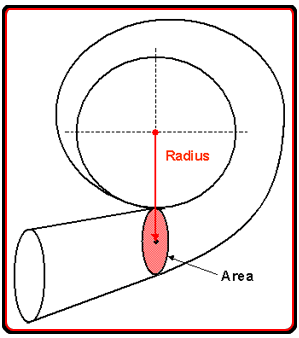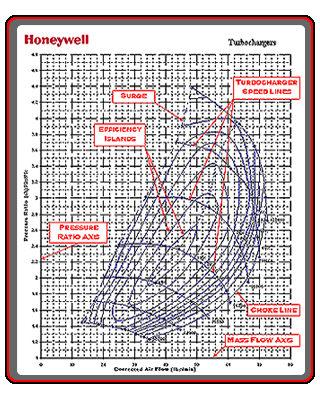I’m not smart enough to be an expert here (not even close), and I’m
an auto guy (read dangerous when it comes to re-applying knowledge to airplanes).
But, here’s what I know/believe…
The A/R ratio is typically cast into the housing (visually obvious on
the exterior/face if you look closely).
The A/R describes the compressor and turbine housing geometry. It is
defined as the turbine inlet cross-sectional area divided by the radius from
the turbo centerline to the centroid of that area. (see diagram below)

• Compressor A/R - Compressor performance is largely insensitive
to changes in A/R, but generally larger A/R housings are used to optimize the
performance for low boost applications, and smaller housings are used for high
boost applications.
• Turbine A/R - Turbine performance is greatly affected by
changing the A/R of the housing. Turbine A/R is used to adjust the flow
capacity of the turbine. Using a smaller A/R will increase the exhaust gas
velocity into the turbine wheel, causing the wheel to spin faster at lower
engine RPMs. This gives quicker turbo response in autos (less important
in planes) and will sustain boost pressure for cabin bleed air during low
throttle descents from altitudes (important in pressurized aircraft). This
will also tend to increase exhaust backpressure, reduce economy, and reduce the
max power at high RPM. Conversely, using a larger A/R will lower exhaust
gas velocity, create less back pressure, better efficiency, but will delay
boost response/rise, and create lower boost at low RPM’s.
There is much more to sizing a tubro to a given application that just
the turbine A/R ratio. For example, the “compressor map”
defines the applicable operating range for a compressor.

The Garrett web-site has some good “basics” reading if you’re
interested. However, it is mostly oriented to auto’s, and hence
must be read with a critical mind when it comes to aircraft applications (http://www.turbobygarrett.com/turbobygarrett/tech_center/tech_center.html)
I don’t have any personally experience on available heat with low
power settings (descents) – never owned a turbo aircraft before. I
would imagine if you are high enough, 29” MP is still quite a bit of boost
(air compression heat generated) relative to the ambient pressure at that
altitude (say 18,000+). If you are lower, i.e. below 10,000, then I might
guess that the available heat from compression is reduced when MP (power) is
low due to the fact that little compression is being performed by the tubros
(hence little heat generated). I would be interested in other’s
real facts/experiences as well.
Rick
________________________________________
From: Lancair Mailing List
[mailto:lml@lancaironline.net] On Behalf Of colyncase on earthlink
Sent: Saturday, April 15, 2006 12:23 AM
To: Lancair Mailing List
Subject: [LML] Re: TSIO-550 Turbo setup for non-pressurizedLlancairs
Richard can you further explain the A/R issue? Are you talking
about the turbine or the compressor?
And can you say a little more about how these different ratios are
implemented?
I have "larger" compressors with the same turbines on my IVP
but I don't know anything about this ratio.
Also I wonder if IVP drivers all have a lack of heat on
descent. This is the first I've heard of that problem.
Colyn
________________________________________
This email message is for the sole use of the intended recipient(s) and
may contain confidential information. Any unauthorized review, use,
disclosure or distribution is prohibited. If you are not the intended
recipient, please contact the sender by reply email and destroy all copies of
the original message.
________________________________________